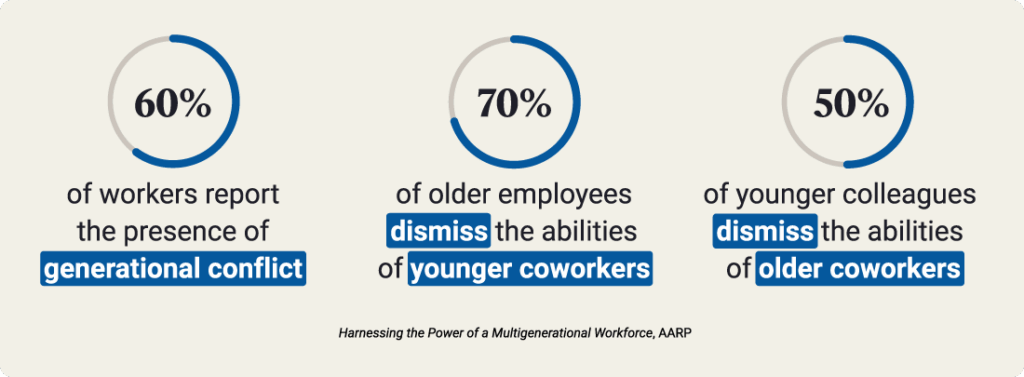


Generational diversity is a topic that is on the minds of every forward-thinking organization these days. The modern business environment sees a confluence of several different generations—traditionalists, baby boomers, generation X, generation Y, generation Z—all with different work styles, techniques, attitudes, and expectations for the office environment.
Organizations can fall into the trap of going with “what we know” and sticking with the thoughts and ideas of a specific generation of workers. Today’s start-ups might lean heavily towards preferred adaptability, worldliness, and tech-forward thinking of generation “Y” or generation “Z”; more established companies might go for what they see as the steadiness and productivity of baby boomers or “gen-X” workers.
Organizations may also sit in a general state of discomfort and uncertainty with how to contend with intergenerational conflict. A landmark AARP study found that:

Most would acknowledge that there are benefits of generational diversity. Another study from the AARP shows that “83 percent of global business leaders recognize that multigenerational workforces are key to the growth and long-term success of their companies.” Still, the gap between how generations tend to perceive one another is enough to keep organizations thinking about how they manage this specific dimension of diversity.
In their book Gentelligence: A Revolutionary Approach to Leading an Intergenerational Workforce, Megan Gerhardt and colleagues argue that this multigenerational workforce should be reframed as a profound business opportunity. “Gentelligence” challenges organizations to reject common stereotypes assigned to different generations, replacing them with a deep understanding of why those who grew up in different times may behave in unique and valuable. Doing so allows leaders to go beyond simply accepting generational differences to leverage them proactively to increase engagement, innovation, and organizational success.
Again, the evidence shows that a generationally-diverse workforce is a successful workforce—and here’s why.
In a Randstad study, 85% of respondents said that they come up with innovative ideas and solutions thanks to an age-diverse team. It’s easy to see why different generations in the workplace can help both of these key drivers to success. More experienced employees could offer time-honored and proven ways of creating or streamlining projects, while younger employees could bring in solutions driven by technology or more cutting-edge ways of thinking. Try developing teams with a cross-generational mixture of talent to create innovative solutions and projects bolstered by a wide range of thinking and experience.
The best insight into a customer group comes from the people that are actually part of that customer group! A workforce made up of all millennials might not have their finger on the pulse of what buyers from Generation X might want – and vice versa. Without valuable, first-hand input from people that are actually in the customer base you’re targeting, everything from project development to marketing and distribution might suffer. A generationally diverse workforce is one that can effectively market a company’s projects and services to the widest group of people.
Generational diversity offers valuable opportunities for each generation to learn new perspectives and skills from the other. Older employees—those who came of age when face-to-face meetings and in-person collaboration were the primary communication methods—have valuable lessons and wisdom to share about person-to-person interactions, customer service, and much more. Younger employees can impart the new workforce’s technology and digital collaboration skills and even some elusive “work-life balance” that benefits every generation’s mental health. A workforce made up of different generations can learn the best work habits from each generation—creating a well-rounded and flexible workforce.
Of course, the bottom line is always the concern for organizations – and generational diversity (spurned on by all the reasons listed above) is one of the landmark features of a profitable company. Companies that are more diverse in their management teams (including age diversity) had 19% higher innovation profits than those companies with less diversity on those same teams.
For one age-specific example, this Harvard Business Review article entitled “The Case For Hiring Older Workers” points out that:
The big takeaway for modern organizations? Consider generational diversity in your hiring practices and team construction; generational diversity makes organizations more innovative, helps connect with customers, introduces new perspectives and skills, and helps bolster profits.
Generational diversity training helps organizations move beyond awareness into action. A strong curriculum equips employees and leaders to understand age-related dynamics, reduce conflict, and harness the strengths of every generation. Core components include:
Through self-paced e-learning modules, participants explore what generational diversity in the workplace means, why it matters, and how five major cohorts—Silent Generation, Baby Boomers, Gen X, Millennials, and Gen Z—have been shaped by formative events. Elearning courses also address and debunk common stereotypes to encourage curiosity rather than assumptions.
In interactive workshops, employees practice adapting communication styles for different audiences. Role-play exercises demonstrate how tone, speed, and format (such as face-to-face, email, messaging, and video) can either bridge or widen generational gaps. Micro-learning refreshers, like email nudges, short tip sheets, or videos, can help reinforce listening and feedback techniques.
Leaders can benefit from coaching sessions that help them identify and address unconscious age bias. They also learn techniques for creating psychologically safe environments where contributions from all generations are valued and practice balancing varied work styles in real workplace situations. A key focus is creating opportunities for cross-generational and reverse mentoring, which accelerate knowledge transfer, spark innovation through diverse perspectives, and build stronger trust across age groups.
To ensure learning translates into behavior, trainings and discussion-based workshops that explore real-world examples of intergenerational conflict and success. Participants analyze scenarios, apply frameworks, and then use follow-up elearning to reflect on how generational strengths can be leveraged in current projects.
When delivered through a mix of formats—e-learning for foundational knowledge, workshops for hands-on practice, micro-learning for reinforcement, and coaching for leaders—these core components create lasting skills and an age-inclusive culture where generational differences drive innovation and performance.
Implementing generational diversity in your organization requires intentional strategies that go beyond awareness. These six actions help leaders and teams harness the unique strengths of every generation, boost engagement, and drive results:
By integrating a mix of these strategies, organizations can transform generational diversity into a competitive edge that drives innovation and long-term success.
At Aperian, we help organizations turn their multigenerational workforces into a source of strength, innovation, and growth. Whether through training, coaching, or tailored strategies, we partner with you to build teams that thrive across generations.
Contact us today to see how we can help you create an age-inclusive workplace where every generation contributes to your success.